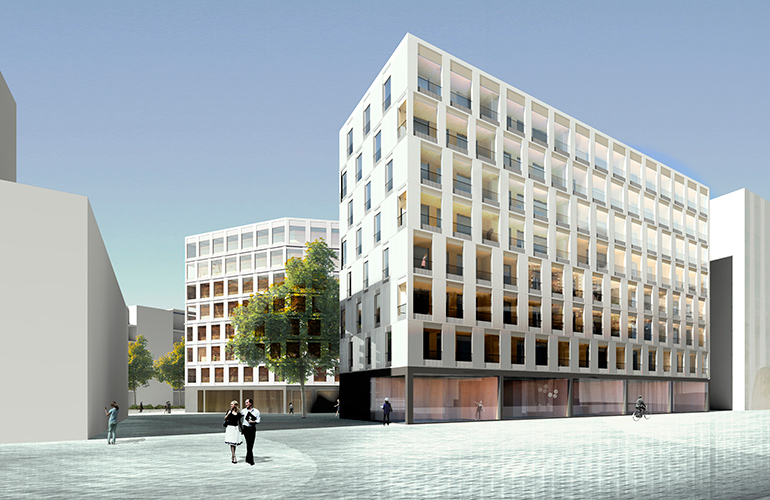Wood and other competing construction materials all co-exist to create safe and sound buildings for people to live and work in. But wood is special in a way its competitors are not: more of it grows in our forests all the time. CO<sub>2</sub> is absorbed into a growing tree’s fibres, where it stays through harvesting, product lifetime, and recycling. A single cubic metre of Cross Laminated Timber (CLT), for example, stores about 700 kg of CO<sub>2</sub>*, making wooden buildings massive carbon stocks.
“The carbon footprint of lightweight concrete, for example, is almost three times bigger than that of dry timber**; so the more we can increase the use of wood as a building material around the world, the better,” explains Jari Suominen, Head of Stora Enso’s Wood Products division.
In spring 2017, the company joined the World Green Building Council’s Europe Regional Network to encourage the EU to support sustainable construction in Europe.
“2017 has been a big year for sustainable building in Europe,” says James Drinkwater, the network’s Regional Director. “In the summer we saw the release of the EU’s first policy aimed at moving towards a ‘common language’ for assessing sustainable building. We were happy to have Stora Enso host the first national implementation workshop.”
The Wood City residental building complex in Helsinki, Finland, will be built using Stora Enso's Laminated Veneer Lumber (LVL).
Wood – so much to love
Building with wood is no new idea in the Nordic countries, but even here buildings made with solid wood have been quite low, typically no more than two storeys. But in recent years, as new innovations have made wood suitable for uses earlier dominated by concrete and steel, designers and city planners have become increasingly interested in tall, multi-storey wooden buildings. And why not − being a carbon stock is just one of many benefits that come with wood construction.“Major wooden building elements such as CLT and LVL are delivered pre-fabricated, which can cut construction time in half,” says Suominen. “In addition, studies have shown that wooden building elements create healthy living environments. Wood construction is also a non-fossil solution that creates less waste throughout the supply chain.”
Indeed, when a wooden building is taken apart, it is not waste but a recyclable, reusable material, still storing carbon. Their carbon content is only released into the atmosphere as CO<sub>2</sub> when the wood eventually decomposes, or is burnt for bioenergy. By then, new trees will have grown, and are ready to absorb that CO<sub>2</sub> back in. This loop can contribute to the circular economy thinking endorsed by the EU.
“The EU’s new framework is a humble start towards truly circular buildings, in which each stage of the lifecycle is considered to create a continuous, closed loop of resources where materials are not lost or wasted,” says James Drinkwater.
Your choices matter
The walls are not the only carbon sinks in a wooden home. Carbon is also stored in many things you use on a daily basis, like food containers, newspapers, and furniture. Choosing wood- or fibre-based products can help reduce your carbon footprint, so it matters what you spend your money on.
“Awareness of sustainable materials is growing, making concrete, plastics and other non-renewable materials less popular,” says Noel Morrin, EVP Sustainability at Stora Enso. “Building developers, converters, brand owners, and consumers are all looking for better options. Stora Enso’s raw material base of trees keeps growing and absorbing carbon dioxide, and we trace 100% of it to make sure it comes from sustainable sources. This makes us an attractive alternative for customers keen to make more responsible choices.”
“Wood is the best answer to this growing customer and consumer demand for environmentally sound options. It is a genuinely sustainable alternative in the fight against global warming,” Suominen adds.
As Stora Enso supplies hundreds of thousands of cubic metres of wood every year to construction sites all over the world, offering this renewable option to its customers makes a big difference. During 2017 the company will deliver 6 300 m3 of Cross Laminated Timber (CLT) to a wooden building project in Växjö, Sweden, for instance. This amount of wood will keep more than 4 400 tonnes of CO<sub>2</sub> from the atmosphere for decades to come – the equivalent of emissions from nearly two thousand round-trip flights from Sydney to New York. Now, that’s heroic.
|
Wooden buildings typically remain in use for 50-100 years, but some stand strong for centuries:
|
*Source: Environmental Product Declaration of Stora Enso's CLT (third-party verified)
**Source: VTT Technology 115 and the European ECO2 project, 2013
Photo by MDH Arkitekte / Woodcon






